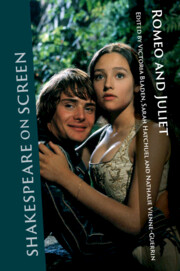Book contents
- Shakespeare on Screen: Romeo and Juliet
- Series page
- Shakespeare on Screen: Romeo and Juliet
- Copyright page
- Dedication
- Contents
- Figures
- Notes on Contributors
- Series Editors’ Preface
- Acknowledgements
- Chapter 1 Introduction – From Canon to Queer: Romeo and Juliet on Screen
- Part I Revisiting the Canon
- Part II Extending Genre
- Part III Serial and Queer Romeo and Juliets
- Chapter 11 Romeo and Juliet, Again and Again: Star-Crossed Lovers Adapted to Serial Television
- Chapter 12 Romeo and Juliet in the Japanese Anime Candy Candy: The Balcony Scene between Tradition and Subversion
- Chapter 13 The (Un)Queering of Romeo and Juliet on Film
- Chapter 14 Romeo and Juliet and Queer Temporality in Three Twenty-first-century Streaming Web-Series
- Chapter 15 Reviving Juliet and Surviving Romeo in Shakespeare Web-Series
- Chapter 16 Romeo and Juliet on Screen: Select Film-bibliography
- Index
- References
Chapter 14 - Romeo and Juliet and Queer Temporality in Three Twenty-first-century Streaming Web-Series
from Part III - Serial and Queer Romeo and Juliets
Published online by Cambridge University Press: 10 October 2023
- Shakespeare on Screen: Romeo and Juliet
- Series page
- Shakespeare on Screen: Romeo and Juliet
- Copyright page
- Dedication
- Contents
- Figures
- Notes on Contributors
- Series Editors’ Preface
- Acknowledgements
- Chapter 1 Introduction – From Canon to Queer: Romeo and Juliet on Screen
- Part I Revisiting the Canon
- Part II Extending Genre
- Part III Serial and Queer Romeo and Juliets
- Chapter 11 Romeo and Juliet, Again and Again: Star-Crossed Lovers Adapted to Serial Television
- Chapter 12 Romeo and Juliet in the Japanese Anime Candy Candy: The Balcony Scene between Tradition and Subversion
- Chapter 13 The (Un)Queering of Romeo and Juliet on Film
- Chapter 14 Romeo and Juliet and Queer Temporality in Three Twenty-first-century Streaming Web-Series
- Chapter 15 Reviving Juliet and Surviving Romeo in Shakespeare Web-Series
- Chapter 16 Romeo and Juliet on Screen: Select Film-bibliography
- Index
- References
Summary
This chapter uses a transmedia approach to compare three international web-series adaptations of Romeo and Juliet: Romeu and Romeu (Brazil, 2016), Rome and Juliet (USA, 2017), and Romil and Jugal (India, 2018/2019), arguing that these shows use transmedia conventions to foreground how they re-write the Shakespearean text. All three shows included at least one protagonist with aspirations to succeed in the performing arts, and included lines from that play as set pieces. All three altered Shakespeare’s tragic ending to conclude with young people who feel supported within their sexuality and with previously hostile families reconciled. But the shows also added additional identity markers – whether of caste, language, social class, able-bodiedness, region or career aspirations – to the conflicts faced by their youthful protagonists, and some of these identity markers overshadowed the romantic plot to such an extent that none of these endings is 'happy' in a traditional or fairy-tale sense. I conclude that the transmedia characteristics of these shows make these adaptations ‘queer’.
Keywords
- Type
- Chapter
- Information
- Shakespeare on Screen: Romeo and Juliet , pp. 214 - 230Publisher: Cambridge University PressPrint publication year: 2023

